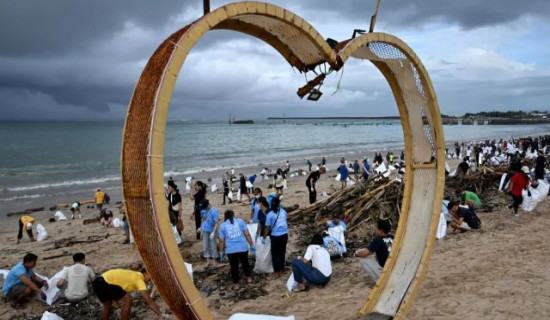- Sunday, 5 January 2025
Bird population shrinking in Narayani River bank area
By Meena Kandel,Kawasoti, Feb. 5: The wetlands in the Nawalpur area which play a vital role in providing habitat for various species, regulating water flow, improving water quality and supporting local communities have shrunk in recent years due to anthropogenic activities. Destruction of the wetlands has endangered various bird species, including eagles, kingfishers, grey herons, coots and storks in the area.
Tikaram Giri, president of the Bird Education Society, said that a quarter of Nepal's 168 endangered bird species are now under threat. He added that alongside the destruction of wetland habitats, waterbirds face crises because of illegal bird hunting and trade, obstruction of flight paths and the effect of climate change.
He added that bird species dependent on wetland habitats, such as lakes, ponds, rivers, reservoirs, irrigated fields and marshy grasslands have significantly declined in recent years.
Sudhan Lamsal, a resident of Kawasoti, said that he observed a significant reduction in bird sightings following the destruction of wetlands in the village. He added that unplanned urbanisation, pollution, and shrinking of wetlands due to human encroachment and the recently constructed concrete pond on wetlands of Chitwan National Park has dwindled the population of waterfowls, both native and migratory.
A concrete pond has been constructed on the wetland situated in the central part of Chitwan National Park. Following the drying up of the marshland, the water birds that used to be previously observed in this area began to disappear.
DB Chowdhary, waterfowl census coordinator of the West Sector of Chitwan National Park, said, “Rivers are being contaminated by sewage and garbage thrown in sources of water, leading to drying up of water bodies. So, the bird population has diminished compared to previous years, as crucial habitats of migratory birds in the vicinity of Chitwan National Park are shrinking.”
According to Chaudhary, “Human activities have led to the shrinking of wetlands adversely affecting aquatic birds both native and migratory. This stark reality is well illustrated in the recent bird counts, where declining numbers directly reflect the consequences of human intervention.”
Ornithologist Basu Bidari said that among the 43 globally rare bird species recorded in Nepal, 12 species are water birds. The number of migratory waterfowl is decreasing due to human activities and development works carried out around wetlands.
Currently, 551 species of birds have been listed in the Narayani River bank area.







WhatsAppImage2025-01-04at5.41.09PM-square-thumb.jpg)







